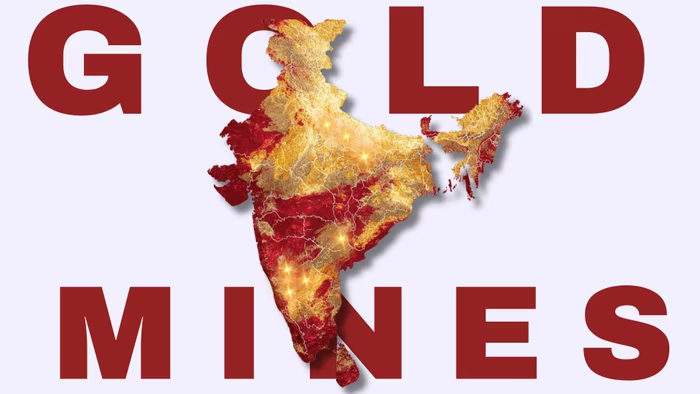Gold has been part of India’s story for thousands of years, from small alluvial panning in riverbedsto the deep, industrial shafts dug by the British.
The old, famous gold belts are mostly in southern and central India: the Kolar and Ramagiri belts and the Hutti greenstone belt in Karnataka are the names everyone remembers.
Commercial-scale mining under British management began in the late 1800s (Kolar and Ramagiri feature heavily in that era).
After independence, the pattern changed: some gold mines in India continued under public ownership, while many smaller workings petered out.
Today, the picture is a mix of one long-running producer, a few historical sites that tourists and researchers visit, and renewed government-led exploration efforts.
Hutti (Hutti–Maski belt) is the single best example of continuity. Modern organised mining at Hutti restarted around 1947–48 after the colonial period, and the company now operates the principal organised gold production in India.
Kolar Gold Fields (KGF): one of the most famous names and gold mines in India, began large commercial operations in the late 19th century but was shut down in 2001 after decades of deep, expensive underground work that became uneconomic for the owners.
Ramagiri (in Andhra Pradesh) was an important early 20th-century producer; its major commercial activity wound down in the late 20th century, and the field is now the subject of exploration interest and local memory.
Why Were Historic Gold Mines in India Closed?
In simple terms, India’s older gold fields tend to be high-grade but narrow veins or very deep shafts.
When the easy parts were exhausted, operators faced very deep underground work, high pumping and ventilation costs, lower ore recovery or falling world prices — and many closures were decided because continued operation would run persistent losses.
KGF is the most visible example: deep mining and rising operating costs made the business unsustainable, which is why it ceased organised production in 2001.
India’s Current & Active Gold Mine Scenario
Hutti produces the bulk, effectively the only continuous commercial producer at scale, while most other “mines” are either small artisanal workings, exploration blocks, or historical sites.
That means India remains one of the world’s largest consumers of gold (jewellery and investment) but a tiny producer in comparison, mined output is measured in low single tonnes per year nationally, while imports and recycling meet the rest of the country’s demand.
Environment and people: older mines left visible legacies. KGF’s tailings, cyanide dumps, and abandoned dug-outs are repeatedly flagged in reporting and scientific studies as sources of soil and groundwater contamination and social hardship for the local community.
Modern regulatory frameworks now require environmental impact assessments, progressive reclamation, and responsible tailings management, but the old sites are a reminder that mining without proper safeguards leaves long-term problems.
Can You Visit Gold Mines in India?
- KGF is historically fascinating but is largely closed and environmentally degraded; visiting needs permissions and local guidance.
- Hutti is a working company area — access is regulated; you’ll see a living mining town rather than ruins.
- Ramagiri is best visited for historical context and local stories; parts of the belt are targets for modern exploration.
Top 10 Gold Mines in India
|
Gold Mine / Belt |
Location (State) |
Started (Modern Ops) |
Closed Year (if any) |
Status |
Key Notes |
|
Hutti Gold Mine (Hutti–Maski belt) |
Raichur, Karnataka |
1947–48 (post-Independence restart) |
– |
Active |
India’s only large-scale producer today, run by Hutti Gold Mines Ltd, with several satellite deposits (Hira-Buddinni, Uti). |
|
Kolar Gold Fields (KGF) |
Kolar, Karnataka |
c. 1880s (British era) |
2001 |
Closed |
Once among the world’s deepest mines, shut due to high costs, low yield, major historical township. |
|
Ramagiri Gold Field |
Anantapur, Andhra Pradesh |
Early 1900s |
2000s (commercial ops ended) |
Inactive |
Historic producer; exploration interest by private firms for revival. |
|
Uti Mine (part of Hutti ops) |
Raichur, Karnataka |
1960s–70s |
– |
Active (satellite) |
Smaller open-pit/satellite mine feeding the Hutti processing plant. |
|
Hira-Buddinni Mine (satellite of Hutti) |
Karnataka |
1900s (historical), revived late 20th c. |
– |
Active/limited |
Narrow vein; contributes ore to the Hutti complex. |
|
Gadag Belt Prospects |
Karnataka |
Ancient workings; modern exploration 1990s |
– |
Exploration |
Identified for gold mineralisation; potential future mine. |
|
Ganajur Project (Deccan Gold Mines Ltd.) |
Haveri, Karnataka |
Exploration drilling 2000s |
– |
Planned Project |
Awaiting clearances; private sector-led. |
|
Sonbhadra (Son Pahadi, Hardi) |
Uttar Pradesh |
Reported deposits in the 2020s |
– |
Exploration |
Clarified by GSI as smaller reserves than early media claims; not yet mined. |
|
Jharkhand Prospects (Parasi/Kunderkocha, Pahadia) |
Jharkhand |
Small mines in the colonial era |
– |
Exploration |
Areas under the Geological Survey/MECL; artisanal activity noted. |
|
Kerala & Maharashtra Minor Belts |
Kerala & Maharashtra |
Historic small-scale |
– |
Inactive/Exploration |
Minor, scattered gold mineralisation; never major producers. |
Key Insights from the Table
- Only one large organised producer is active today: Hutti (with its satellites).
- Kolar Gold Fields is the most famous historically, but it closed in 2001 after over a century of operation.
- Ramagiri and Jharkhand belts show exploration promise, but no commercial mines at scale currently.
- Private sector projects (Ganajur, Gadag, Sonbhadra) are in exploration or approval stages; they show where India’s gold mining future might lie.
- Overall, India has 1 active organised mine, 2–3 smaller satellites, and multiple exploration belts.
Why this list looks different from big international “top 10” tables:India simply doesn’t have many large, continuous modern gold mines in India; most big names are historic, and many of the modern “projects” are still exploration licenses.
Gold mining isn’t just history—it’s business. See which gold stocks shine the brightest in 2025
How Deep Do India’s Gold Mines Go?
India’s gold mines tell a fascinating story of scale and depth. The famous Kolar Gold Fields in Karnataka, now closed, once went as deep as 3.2 kilometers underground, making it one of the deepest gold mines in the world.
Today, the spotlight is on the Hutti Gold Mine, India’s only large-scale producer, which still operates at depths of around 870 meters and historically touched over 1 kilometer below the surface.
The Hutti–Maski belt itself spreads across nearly 850 square kilometers, with satellite mines like Uti (open pit) and Hira-Buddinni adding to production. Beyond these, exploration zones like Ganajur, Gadag, Ramagiri, Sonbhadra, and parts of Jharkhand cover vast areas but are yet to see deep commercial mining. In short, India’s gold story ranges from legendary ultra-deep shafts to promising new belts waiting to be tapped—showing both rich history and future potential.
Gold Mining Process in India
- Exploration — geological mapping, drilling, and assays. GSI/MECL and private firms define where ore exists. (Recent policy changes are encouraging more exploration licenses.)
- Development — build access (shafts, declines, or open-pit benches), plants, and camps. Old Indian fields usually require underground mining.
- Extraction — underground stoping or benching (open pit where geometry allows). Indian historic veins are often narrow, so extraction is labour and skill-intensive.
- Processing — crushing, grinding, gravity concentration (for coarse gold), flotation for sulfide ores, and cyanide leaching or other hydrometallurgical methods to recover gold. Tailings are produced and must be managed.
- Rehabilitation/closure — modern rules require progressive reclamation and tailings safety plans; historical closures often lacked these, producing the environmental problems seen at places like KGF.
Don’t just read about India’s gold mines—let your money dig too! Check out the best gold mutual funds of 2025
India’s gold-mining story is a layered one: ancient small-scale activity and big colonial shafts (KGF), a surviving modern operator (Hutti), and a new policy era that’s trying to spark fresh exploration.
At present, domestic production is tiny relative to demand, but cleaner rules, better exploration tools, and recent reforms (MMDR amendments and the government’s exploration license auctions) are nudging the sector toward more discovery activity.
That said, turning promising drill results into long-lived, profitable gold mines in India faces geological and economic challenges.
Many prospective deposits are narrow or deep and require capital-intensive, environmentally responsible approaches.
From hidden mines to modern markets, gold is everywhere. But the simplest way to start? Save daily in digital gold with Jar.
Frequently Asked Questions (FAQs)
1. Which gold mine in India currently produces the most?
Hutti Gold Mines is the main organised producer and supplies most of India’s mined gold. (Hutti’s company reports and annual statements show it as the principal active operation.)
2. Upcoming gold mines in India?
The government’s MMDR Act amendments and recent policy actions (exploration licence auctions and critical-mineral tranches) are designed to encourage exploration.
Several blocks with gold potential were included in recent rounds of auctions and bids, which means more drilling and hopefully new projects are likely in the coming years, though converting exploration into production takes time.
3. How many gold mines are there in India?
India has around 10 primary gold mines and belts, spread across states like Karnataka, Jharkhand, and Andhra Pradesh. Karnataka alone contributes the maximum, with famous belts like Hutti, Kolar (now closed), and Ramgiri. Though the number looks small, these mines have been the backbone of India’s gold production for decades.
4. Who is the biggest gold mine in India?
The Hutti Gold Mine in Raichur district, Karnataka is the biggest operational gold mine in India. It has been running for more than a century and still contributes the bulk of India’s domestic gold output. Managed by Hutti Gold Mines Company Limited (HGML), it is truly the heart of Indian gold mining.
5. Which is the first gold mine of India?
The Kolar Gold Fields (KGF) in Karnataka hold the title of India’s first major gold mine. Mining here started in the late 19th century under British rule, making KGF one of the deepest and most historic gold mines in the world. Although it shut operations in 2001, its legacy still shines bright in Indian mining history.
6. Which city is famous for gold mines?
Raichur in Karnataka is most famous for its gold mines, thanks to the legendary Hutti belt. Similarly, the Kolar region was world-renowned for gold before the mines closed. Even today, when people think of gold mining in India, Karnataka cities like Raichur and Kolar instantly come to mind.










